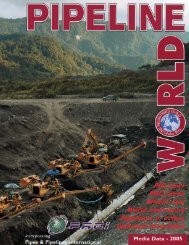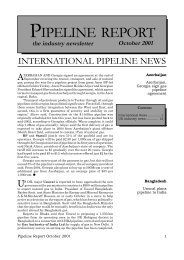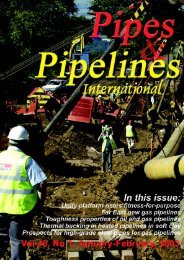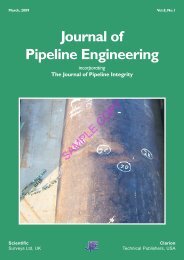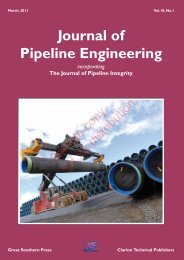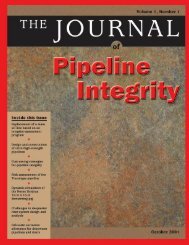JPE - Sept09 - cover2-4.pmd - Pipes & Pipelines International ...
JPE - Sept09 - cover2-4.pmd - Pipes & Pipelines International ...
JPE - Sept09 - cover2-4.pmd - Pipes & Pipelines International ...
You also want an ePaper? Increase the reach of your titles
YUMPU automatically turns print PDFs into web optimized ePapers that Google loves.
160<br />
J, N/mm<br />
80<br />
60<br />
40<br />
20<br />
case (height = 3mm, length = 50mm, ligament =<br />
3mm), the following is observed based on results in<br />
Table 2:<br />
• increasing the height from 3 to 6 and 9mm<br />
leads to reductions in M of 3.8 and<br />
J2B E 0.5%<br />
5.5%, respectively;<br />
• increasing the ligament from 3 to 6 and<br />
9mm, leads to increases in M of 1.8<br />
J2B E 0.5%<br />
and 2.3%, respectively;<br />
• increasing the length from 50 to 100 and<br />
200mm leads to reductions in M of<br />
J2B E 0.5%<br />
1.1 and 1.8%, respectively.<br />
• The J-based limit loads for flaws located at a given<br />
ligament from the ID are nearly equal to those for<br />
flaws located at the same ligament from the OD (for<br />
example E1BH3L50L3M0 and E1BH3L50L14M0).<br />
• M J2B E (with J e based on the elastic pipe bending<br />
stress) is higher than M J2B EP (with J e based on the<br />
elastic-plastic pipe-bending stress) by approximately<br />
4%. This is not surprising since in the former case,<br />
for a given load level, the elastic driving force (J e ) and<br />
f(L r ) are higher, L r is lower, and M J is higher, see<br />
Equns 2 and 7.<br />
Comparison of flat-plate solutions<br />
with J-based solutions<br />
To facilitate comparison of the J-based limit loads with the<br />
codified flat-plate solutions reviewed earlier, the M J results<br />
The Journal of Pipeline Engineering<br />
OD=400mm, t=20mm, e=0.0mm. Embedded flaw near ID: 2a=3.0mm, 2c=50.0mm, pi=3mm, 'E1BH3L50L3M0'<br />
J estimate based on σ ref/σ M1 determined at 0.5% strain<br />
J max (FEA)<br />
J estimate based on M J2B EP 0.5% x (σ M1/σ M)<br />
J estimate based on M J2B EP 0.5%<br />
J estimate based on Global collapse,<br />
0<br />
0.1 0.2 0.3 0.4 0.5 0.6 0.7 0.8 0.9 1.0<br />
Remote strain %<br />
Fig. 11. J results for model E1BH3L50L3M0 (from FEA and based on estimates of limit moment).<br />
(M J2B E 0.5% and M J2B EP 0.5% ) were expressed in terms of the<br />
non-dimensional parameter s ref /s M1 , where s M1 is the elasticplastic<br />
pipe-bending stress, and compared with s ref /s M1<br />
determined from the flat-plate solutions (as 1/n L ). The<br />
results are given in Table 3. The same results are reproduced<br />
as the ratio of s ref from the flat-plate solutions to s ref from<br />
M J2B EP 0.5% in Table 4. The following conclusions are drawn:<br />
Sample issue<br />
• s ref /s M1 estimates based on flat-plate solutions and<br />
local collapse with pin loading exceed significantly<br />
s ref /s M1 based on M J2B E 0.5% and M J2B EP 0.5% . Therefore,<br />
flat-plate solutions based on local collapse with pin<br />
loading lead to conservative assessments according<br />
to the following ranking (given in order of decreasing<br />
conservatism):<br />
• R6, local collapse, solution (b), pin loading<br />
(Equn 18)<br />
• BS 7910, local collapse, solution (a), pin<br />
loading (Equn 11)<br />
• R6, local collapse, solution (a), pin loading<br />
(Equn 15)<br />
• Table 4 shows that the BS 7910 flat-plate s ref solution<br />
exceeds s ref based on M J2B EP 0.5% by a margin which<br />
varies depending on flaw size and ligament. The<br />
margin is higher for deeper and longer flaws. Except<br />
for the shortest flaw considered (length = 25mm)<br />
and shallow flaws located near the middle of the<br />
thickness (height = 3mm and ligament >= 6mm) the<br />
margin exceeds 5%. These results apply to the<br />
stress-strain curve considered (low work hardening).



